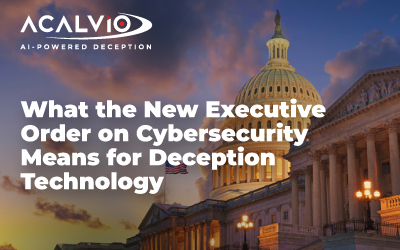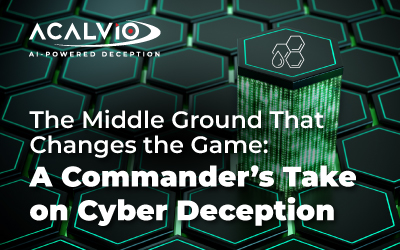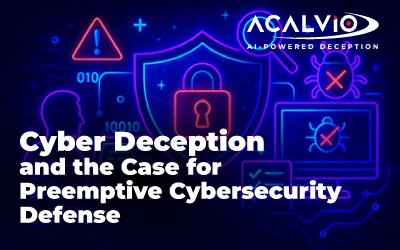
On January 16, 2025, President Biden signed a landmark executive order focused on strengthening and promoting innovation in the nation’s cybersecurity landscape. While the directive addresses a broad range of critical cybersecurity issues, it also creates new opportunities for advanced solutions like deception technology to play a pivotal role in bolstering national cyber defense. Here’s what this means for cyber deception and its potential to transform how organizations and agencies combat cyber threats.
Key Provisions of the Executive Order and Their Implications for Deception Technology
- Establishment of Minimum Cybersecurity Standards The executive order mandates that government contractors adhere to stringent cybersecurity standards and provide evidence of compliance. For deception technology providers, this opens the door to integrate solutions that enhance compliance and security readiness. Deception technologies, such as decoy assets and deceptive network environments, can provide measurable security improvements while meeting these rigorous standards.
- Increased Focus on Combating Ransomware With enhanced sanctions targeting foreign hackers, particularly those deploying ransomware against critical infrastructure, organizations are encouraged to adopt proactive and preemptive defenses. Deception technology offers unique advantages in detecting ransomware actors early, slowing down attacks, and diverting malicious activities away from critical assets—giving organizations critical time to respond.
- Preparation for Quantum Computing Threats Quantum computing poses significant challenges to traditional cybersecurity methods. The executive order highlights the urgency for agencies to address these risks. Deception technology can be tailored to detect and mitigate quantum-enabled cyber threats, ensuring that networks remain secure as adversaries adopt advanced capabilities. Preemptive defenses, such as deception techniques, allow organizations to stay ahead of quantum threats by identifying vulnerabilities before they can be exploited.
- Emphasis on Artificial Intelligence (AI) in Cyber Defense The directive calls for the establishment of AI-driven programs within federal agencies to enhance cyber defenses. This aligns seamlessly with AI-powered deception technology, which uses machine learning to dynamically adapt decoys, analyze attacker behavior, and provide actionable intelligence in real time. Such capabilities are integral to Active Defense strategies, which focus on engaging adversaries directly and turning attacks into opportunities for intelligence gathering.
- Strengthening Software Supply Chain Security The executive order requires vendors to demonstrate secure development practices, highlighting the criticality of protecting the software supply chain. Deception technology can actively monitor supply chain environments, detect anomalies, and intercept threats before they propagate downstream, making it an essential component of any robust supply chain defense strategy. By incorporating deception into Active Defense frameworks, organizations can disrupt attacker efforts and mitigate risks proactively.
- Enhancing Identity and Credential Security A significant focus of the executive order is on securing identities and credentials, recognizing their critical role in preventing unauthorized access and lateral movement within networks. Deception technology can strengthen identity security by deploying deceptive credentials, honeytokens, and fake access points that lure attackers into revealing their tactics. These solutions not only provide early detection of credential-based attacks but also protect legitimate credentials by obfuscating real access pathways. By integrating deception into identity security frameworks, organizations can preemptively identify and neutralize attempts to compromise critical credentials.
Why Deception Technology is Uniquely Positioned to Respond
Deception technology’s ability to proactively engage and mislead adversaries provides a significant advantage over traditional defensive measures. By creating realistic yet isolated environments, deception solutions:
- Confuse and delay attackers, reducing the likelihood of successful breaches.
- Provide organizations with early warnings and actionable intelligence on adversary tactics.
- Offer measurable improvements in meeting compliance requirements and standards set forth by the executive order.
- Serve as a cornerstone of preemptive defense strategies, identifying and neutralizing threats before they can escalate.
- Enhance identity security by safeguarding credentials and monitoring for unauthorized access attempts.
The Road Ahead
This executive order represents a turning point for the cybersecurity industry, placing innovation and proactive defense at the forefront. Deception technology, with its ability to disrupt attacker operations and provide critical insights, is uniquely suited to address many of the challenges outlined in the directive. By adopting deception technologies within an Active Defense framework, organizations can transform their cybersecurity posture from reactive to proactive, engaging threats in a controlled manner to minimize damage and maximize intelligence.
Conclusion
The new executive order underscores the importance of innovation in cybersecurity, presenting a unique opportunity for deception technology to shine. For organizations aiming to stay ahead of emerging threats and compliance requirements, now is the time to integrate deception into their cybersecurity strategy. By doing so, they can proactively defend against adversaries, protect critical assets, and contribute to a more secure national cyber infrastructure. Leveraging preemptive and Active Defense strategies, deception technology ensures organizations are not just responding to threats, but actively shaping the battlefield in their favor.


